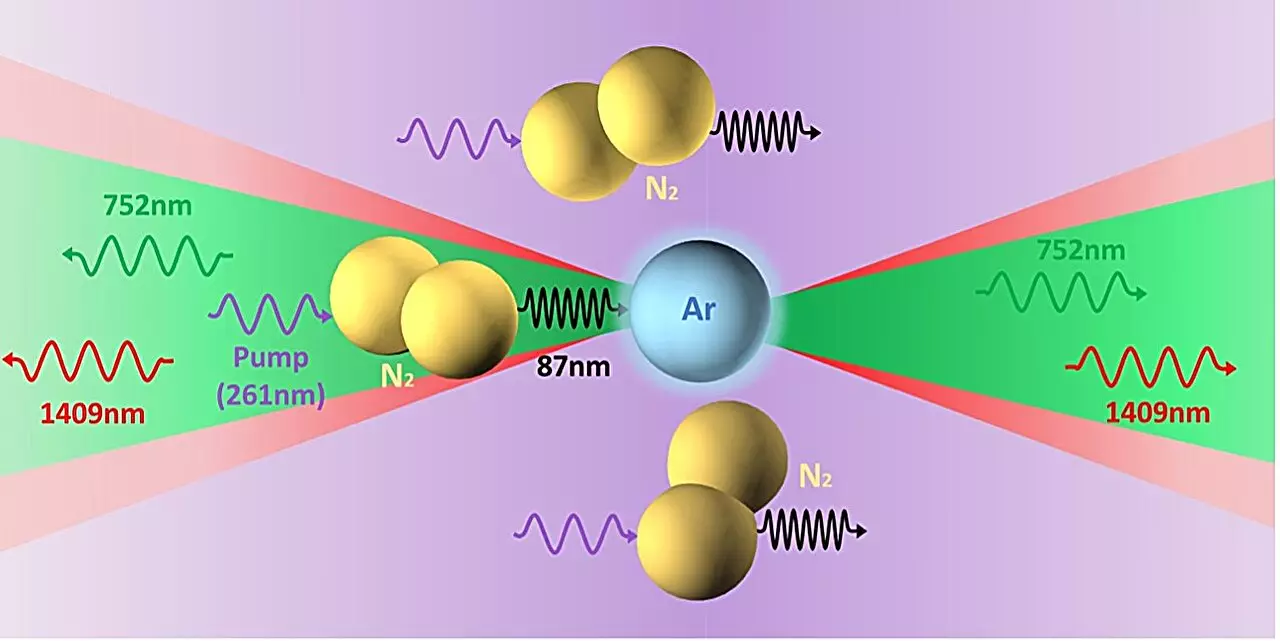Lasers have revolutionized numerous fields by providing precise, coherent light. They typically function through optical cavities, where two mirrors are arranged to direct and amplify light by reflecting it back and forth. This confined setup is critical for maintaining the laser’s intensity and characteristics. However, recent advancements in physics have unveiled an intriguing alternative to this classical method: generating laser-like light in open air, an accomplishment referred to as cavity-free lasing. This process deviates from conventional methodologies and offers a fresh perspective on energy transfer and light emission dynamics.
In a study led by researchers from the University of California Los Angeles (UCLA) and the Max Born Institute, a novel mechanism for cavity-free lasing has been uncovered, providing critical insights into how atmospheric conditions can facilitate this phenomenon. Their findings, published in the esteemed journal Physical Review Letters, highlight a unique energy exchange process between nitrogen (N2) and argon (Ar) atoms. The team focused on the interaction of photons with these gases to understand better how lasing can occur in the absence of a traditional optical cavity.
Co-author Chan Joshi shed light on a surprising observation: when subjected to a pump laser of 261 nm, argon exhibited a significant reduction in ionization rates compared to predictions made by established theories such as the PPT (Power Perturbation Theory) and the time-dependent Schrödinger equation. This led them to hypothesize that a specific interaction known as three-photon resonant absorption might contribute to this unexpected behavior in argon.
Delving deeper into their experiments, Joshi and his colleagues observed a remarkable pathway where three-photon absorption of 261 nm photons by argon atoms resulted in cascaded superfluorescent light emission. What sets this discovery apart is the emission pattern: it was bidirectional, resembling the behavior of traditional lasers without requiring an optical cavity. Lead author Zan Nie pointed out an interesting twist—using air that was mixed with a small percentage of argon resulted in a shift in emission wavelengths, which was not anticipated. This revelation highlighted a new mechanism for air lasing, facilitating energy transfers between the nitrogen and argon components of the atmosphere.
The researchers ingeniously demonstrated that mixing nitrogen with argon yielded similar results to those observed with ambient air, while combinations with other gases like oxygen and helium did not exhibit the same lasing properties. This critical distinction suggested that the coupling of nitrogen and argon is fundamental to the lasing process.
A further exploration into the properties of excited nitrogen molecules unearthed a complex interaction characterized by nonlinear-3-photon absorption at frequencies distinct from argon. This frequency shift plays a pivotal role in the cascading superfluorescence phenomena observed in the air. By providing a theoretical model, the researchers were able to demystify the intricate mechanisms that govern this surprising lasing behavior.
Misha Ivanov, another co-author of the study, expressed enthusiasm regarding the potential applications of cavity-free lasing. The prospect of achieving bidirectional laser emission—where a beam of light shot into the atmosphere triggers a corresponding laser-like response—opens new dimensions for remote sensing and other technological innovations. This advancement not only represents a significant scientific milestone but also showcases the creative possibilities within atmospheric physics.
As researchers continue to investigate the parameters of this novel lasing mechanism, there is considerable anticipation regarding its implications. The ability to effectively harness energy transfers in air could lead to groundbreaking applications in remote sensing technologies, enabling more precise measurements and data collection from afar. Enhanced understanding of quantum beating and the excitation of multiple energy levels in argon will further refine the theory, potentially revealing undiscovered aspects of both argon and nitrogen that are crucial to this process.
The recent discoveries regarding cavity-free lasing represent a pivotal moment in the evolution of laser technology. By advancing our understanding of how light interacts with atmospheric components, scientists are paving the way for innovative applications that could redefine remote sensing and other fields reliant on precise light manipulation. The implications of this research extend far beyond the laboratory, promising exciting possibilities for real-world applications that harness the power of the atmosphere.


Leave a Reply